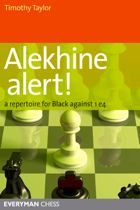Alekhine Alert
A Repertoire for Black Against 1.e4
Timothy Taylor

Black has many choices when facing 1.e4. Certainly in terms of popularity and soundness the Sicilian and 1…e5 have to rank at the top followed by the Caro-Kann and French, but what of the Alekhine, Pirc/Modern and Scandinavian (1…Nc6 is still looking for a champion)?
The past decade has seen even the worlds best adopt these so-called “second-line defenses partly due to new discoveries and partly a desire to avoid preparation by playing as wide a repertoire as possible. While the Alekhine has experienced a resurgence of interest, until recently there was no up to date guide to this opening. IM Tim Taylors Alekhine Alert answers this need.
Written in the style of an repertoire guide, Taylors book does not try to cover all of the Alekhine there is nothing on 1.e4 Nf6 2.e5 Nd5 3.d4 d6 4.Nf3 Bg4 for example. A quick glance at the table of contents gives an idea of what is offered (I have added the variations when relevant).
Contents Bibliography 5 Introduction 7 1
World Champions Play Alekhines Defence 12
Our Hero: Alekhine 2
Modern Variation I:
The White Pawn Wedge 35
Our Hero: Bagirov 3
Modern Variation II: A Danish/Latvian Co-Production 52
Our Hero: Kengis (1.e4 Nf6 2.e5 Nd5 3.d4 d6 4.Nf3 dxe5 5.Nxe5 g6) 4
Modern Variation III: Vikings Board the Alekhine Longboat 84
Our Hero: Carlsen (1.e4 Nf6 2.e5 Nd5 3.d4 d6 4.Nf3 dxe5 5.Nxe5 c6) 5
Exchange Variation: The Ox is not a Scary Animal 118
Our Hero: Larsen (1.e4 Nf6 2.e5 Nd5 3.d4 d6 4.c4 Nb6 5.exd6 exd6) 6
The Four Pawns Attack Fracture Him! 152
Our Hero: Sergeev (1.e4 Nf6 2.e5 Nd5 3.d4 d6 4.c4 Nb6 5.f4 g6) 7
The Chase Variation Back to the Centre 182
Our Hero: Korchnoi (1.e4 Nf6 2.e5 Nd5 3.c4 Nb6 4.c5 Nd5 5.Bc4 e6 6.Nc3 Nxc3 7.dxc3 Nc6 8.Bf4 Bxc5 9.Qg4 g5! 8
Fourth or Fifth Move Sidelines 208
Our Hero: Vaganian 9
Third Move Sidelines 224
Our Hero: Varga 10
Alekhine Declined 238
Our Hero: Taylor (1.e4 Nf6 2.Nc3 e5)
As one might guess from the chapter headlines, Taylor has a lively writing style. Alekhine Alert is not only informative but also fun to read. Taylor not only expounds on the theory and ideas behind the variations he recommends but explains why he did not choose others like 1.e4 Nf6 2.e5 Nd5 3.d4 d6 4.Nf3 dxe5 5.Nxe5 Nd7. This is a book written for the practical player so Taylor writes that after 6.Nxf7, Black may be fine theoretically but a real game would be a different matter. The analysis is long and easily forgotten and one slip would mean immediate loss.
Similarly, he recommends the relatively uncharted 5…g6 against the Four Pawns Attack, a line that the Alekhine player is seldom likely to meet. Taylor often goes his own way compared to previous books on the Alekhine, most noticeably in his advocacy of 2…e5 after 1.e4 Nf6 2.Nc3. He strongly believes that White is better after 2…d5, which tries to keep the game in pure Alekhine territory.
Taylor provides analysis of the Vienna and Four Knights Game after 1.e4 Nf6 2.Nc3 e5 but it should be pointed out that White has a third option in 3.d4 heading for the Center Game after 3…exd4 4.Qxd4 Nc6 5.Qe3 or 5.Qa4 as the independent 3…Bb4 (analogous to the Four Knight’s Scotch line 1.e4 e5 2.Nf3 Nc6 3.Nc3 Nf6 4.d4 Bb4) seems to fail to 4.dxe5 Nxe4 5.Qg4. This is only a small oversight in a fine book as the Center Game is not theoretically dangerous. Alekhine Alert can be warmly recommended to players from 1800 to 2400 who are looking for an uncompromising defense to 1.e4.
